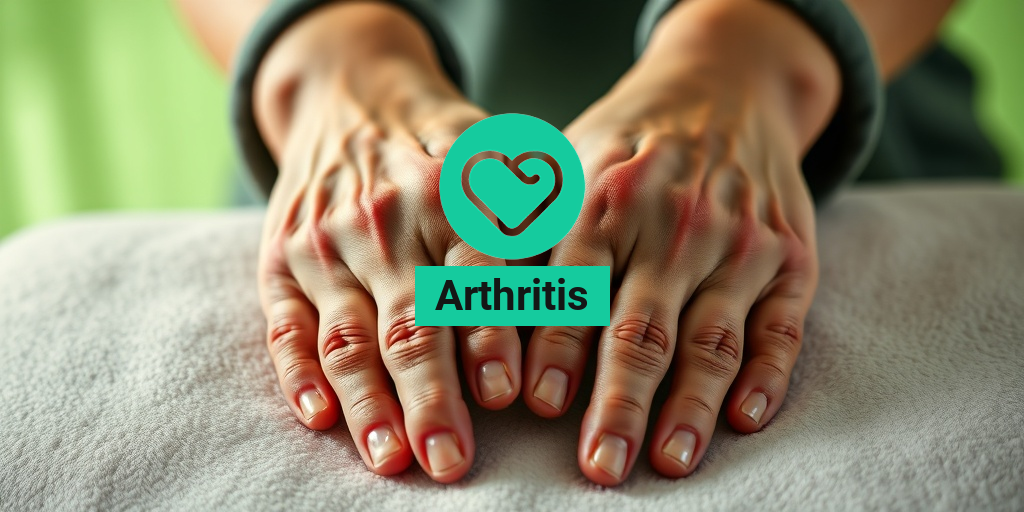What Is Arthritis?
Arthritis is a term that encompasses over 100 different conditions affecting the joints, which are the areas where two or more bones meet. The most common types of arthritis include osteoarthritis and rheumatoid arthritis. This condition can lead to pain, swelling, stiffness, and decreased mobility, significantly impacting daily life.
In simple terms, arthritis refers to inflammation of the joints. This inflammation can result from various factors, including wear and tear on the joints, autoimmune disorders, infections, or metabolic issues. Understanding the underlying causes of arthritis is crucial for effective management and treatment.
Types of Arthritis
- Osteoarthritis: The most prevalent form, often referred to as “wear and tear” arthritis, typically occurs with age and involves the gradual breakdown of cartilage.
- Rheumatoid Arthritis: An autoimmune disorder where the body’s immune system mistakenly attacks the joints, leading to inflammation and pain.
- Gout: A type of inflammatory arthritis characterized by sudden and severe pain, often in the big toe, caused by the accumulation of uric acid crystals.
- Psoriatic Arthritis: Associated with psoriasis, this type can affect both the skin and joints, leading to swelling and discomfort.
Each type of arthritis has its unique characteristics and treatment approaches. If you suspect you have arthritis, it’s essential to consult a healthcare professional for an accurate diagnosis and tailored treatment plan.
Arthritis Symptoms
Recognizing the symptoms of arthritis is vital for early diagnosis and effective management. While symptoms can vary depending on the type of arthritis, some common signs include:
Common Symptoms of Arthritis
- Joint Pain: Persistent pain in the joints is often the first noticeable symptom. This pain can be constant or may come and go.
- Swelling: Inflammation can cause the joints to swell, making them appear larger than usual.
- Stiffness: Many individuals experience stiffness, especially in the morning or after sitting for extended periods.
- Reduced Range of Motion: Arthritis can limit how far you can move your joints, making everyday activities challenging.
- Fatigue: Chronic inflammation can lead to feelings of tiredness and a general lack of energy.
Specific Symptoms by Type
Different types of arthritis may present unique symptoms. For instance:
- Rheumatoid Arthritis: Often affects both sides of the body symmetrically and may include symptoms like fever and weight loss.
- Gout: Characterized by sudden, intense pain and redness in the affected joint, often the big toe.
- Psoriatic Arthritis: May include skin symptoms like red patches of skin covered with thick, silvery scales.
If you notice any of these symptoms, especially persistent joint pain or swelling, it’s crucial to seek medical advice. Early intervention can help manage symptoms and improve quality of life.
Managing Arthritis Symptoms
While there is no cure for arthritis, various treatment options can help manage symptoms effectively. These may include:
- Medications: Over-the-counter pain relievers, anti-inflammatory drugs, and disease-modifying antirheumatic drugs (DMARDs) can help alleviate symptoms.
- Physical Therapy: Engaging in physical therapy can improve joint function and reduce stiffness.
- Lifestyle Changes: Maintaining a healthy weight, regular exercise, and a balanced diet can significantly impact arthritis management.
- Alternative Therapies: Some individuals find relief through acupuncture, massage, or the use of CBD products.
For more comprehensive information and evidence-based health answers, consider visiting Yesil Health AI. They provide valuable resources to help you navigate your health journey.
In conclusion, understanding arthritis and its symptoms is the first step toward effective management. If you or someone you know is experiencing symptoms, don’t hesitate to reach out to a healthcare professional for guidance. Remember, you are not alone in this journey! 🌟

Types of Arthritis
Arthritis is a broad term that encompasses over 100 different types of joint diseases and conditions. Each type has its own unique characteristics, symptoms, and treatment options. Understanding the various types of arthritis can help you identify your condition and seek appropriate care. Here are some of the most common types:
1. Osteoarthritis (OA)
Osteoarthritis is the most prevalent form of arthritis, often referred to as “wear and tear” arthritis. It occurs when the protective cartilage that cushions the ends of the bones wears down over time. This type of arthritis typically affects weight-bearing joints such as the knees, hips, and spine, but it can also impact the hands.
2. Rheumatoid Arthritis (RA)
Rheumatoid arthritis is an autoimmune disorder where the immune system mistakenly attacks the synovium—the lining of the membranes that surround the joints. This leads to inflammation, pain, and eventually joint damage. RA often affects joints on both sides of the body, such as wrists, knees, and fingers.
3. Psoriatic Arthritis (PsA)
Psoriatic arthritis is associated with the skin condition psoriasis. It can cause joint pain, stiffness, and swelling, and may also lead to changes in the nails. PsA can affect any joint in the body and may vary in severity from mild to severe.
4. Gout
Gout is a type of inflammatory arthritis that occurs when uric acid builds up in the blood, forming crystals in the joints. This condition often leads to sudden and severe episodes of pain, redness, and swelling, commonly affecting the big toe.
5. Juvenile Arthritis (JA)
Juvenile arthritis refers to arthritis that occurs in children under the age of 16. It encompasses several types, including oligoarticular and polyarticular arthritis. Symptoms can vary widely, and early diagnosis is crucial for effective management.
6. Ankylosing Spondylitis (AS)
Ankylosing spondylitis is a chronic inflammatory arthritis that primarily affects the spine and the sacroiliac joints in the pelvis. It can lead to severe, chronic pain and discomfort, and in some cases, it may cause the vertebrae to fuse together, resulting in a rigid spine.
7. Reactive Arthritis
Reactive arthritis is a type of inflammatory arthritis that occurs as a reaction to an infection in another part of the body, often the urinary tract or gastrointestinal system. Symptoms typically include joint pain and swelling, often affecting the knees, ankles, and feet.
Arthritis Causes
The causes of arthritis can vary significantly depending on the type of arthritis. While some forms are linked to genetic factors, others may be triggered by environmental influences or lifestyle choices. Here are some common causes associated with different types of arthritis:
1. Genetic Factors
Many types of arthritis, including rheumatoid arthritis and ankylosing spondylitis, have a genetic component. If you have a family history of arthritis, you may be at a higher risk of developing the condition yourself.
2. Age
Age is a significant risk factor for many types of arthritis. Osteoarthritis, for example, is more common in older adults due to the cumulative wear and tear on joints over time. As we age, our bodies may become less resilient, making us more susceptible to joint issues.
3. Previous Joint Injuries
Injuries to joints, such as fractures or ligament tears, can increase the risk of developing arthritis later in life. This is particularly true for osteoarthritis, where previous injuries can lead to joint degeneration.
4. Obesity
Obesity is a significant risk factor for osteoarthritis, especially in weight-bearing joints like the knees and hips. Excess weight puts additional stress on these joints, leading to increased wear and tear.
5. Autoimmune Disorders
In conditions like rheumatoid arthritis, the body’s immune system mistakenly attacks its own tissues, leading to inflammation and joint damage. The exact cause of this immune response is not fully understood, but it is believed to involve a combination of genetic and environmental factors.
6. Infections
Some types of arthritis, such as reactive arthritis, can develop after an infection in another part of the body. Bacterial or viral infections can trigger inflammation in the joints, leading to pain and swelling.
7. Lifestyle Factors
Certain lifestyle choices, such as a sedentary lifestyle, smoking, and poor diet, can contribute to the development of arthritis. Maintaining a healthy weight, staying active, and eating a balanced diet rich in anti-inflammatory foods can help reduce the risk.
Understanding the types and causes of arthritis is essential for effective management and treatment. If you suspect you have arthritis or are experiencing joint pain, it’s important to consult with a healthcare professional for a proper diagnosis and personalized treatment plan. 🩺

Arthritis Risk Factors
Arthritis is a common condition that affects millions of people worldwide. Understanding the risk factors associated with arthritis can help in early detection and management. Here, we’ll explore the various factors that may increase your likelihood of developing this condition.
Age
As we age, the risk of developing arthritis increases significantly. This is particularly true for osteoarthritis, which is often referred to as “wear and tear” arthritis. The cartilage that cushions the joints gradually deteriorates, leading to pain and stiffness. In fact, most people over the age of 65 experience some form of arthritis. 🧓
Genetics
Your family history plays a crucial role in your risk of developing arthritis. If your parents or siblings have had arthritis, you may be more likely to develop it yourself. Certain genetic markers have been linked to specific types of arthritis, such as rheumatoid arthritis, making genetics a significant factor to consider.
Gender
Gender can also influence your risk of arthritis. Women are more likely than men to develop rheumatoid arthritis and osteoarthritis, particularly after menopause. Hormonal changes may contribute to this increased risk, highlighting the importance of understanding how gender affects arthritis susceptibility.
Obesity
Excess weight puts additional stress on weight-bearing joints, such as the knees and hips. This added pressure can accelerate the breakdown of cartilage, leading to osteoarthritis. Maintaining a healthy weight through diet and exercise can significantly reduce your risk of developing arthritis. 🏋️♀️
Previous Joint Injuries
Injuries to the joints, such as fractures or ligament tears, can increase the risk of developing arthritis later in life. Even if the injury heals, the joint may be more susceptible to wear and tear, leading to conditions like post-traumatic arthritis.
Occupation
Certain occupations that involve repetitive joint movements or heavy lifting can increase the risk of arthritis. Jobs that require prolonged kneeling, squatting, or heavy lifting can lead to joint damage over time. If you work in such an environment, it’s essential to take preventive measures to protect your joints.
Other Health Conditions
Having other health conditions, such as diabetes or metabolic syndrome, can increase your risk of developing arthritis. Inflammatory conditions, like psoriasis, can also lead to psoriatic arthritis. Managing these underlying health issues is crucial for reducing your overall risk.
Arthritis Diagnosis
Diagnosing arthritis can be a complex process, as there are over 100 different types of arthritis, each with its own set of symptoms and diagnostic criteria. Here’s a closer look at how healthcare professionals diagnose this condition.
Medical History
The first step in diagnosing arthritis typically involves a thorough medical history. Your doctor will ask about your symptoms, including when they began, their severity, and any factors that worsen or relieve them. Be prepared to discuss your family history of arthritis and any previous joint injuries. 🩺
Physical Examination
A physical examination is crucial in the diagnostic process. Your doctor will assess your joints for swelling, tenderness, and range of motion. They may also check for signs of inflammation, such as warmth or redness around the joints.
Imaging Tests
To get a clearer picture of what’s happening in your joints, your doctor may order imaging tests. Common tests include:
- X-rays: These can reveal joint damage and help determine the severity of arthritis.
- Magnetic Resonance Imaging (MRI): This provides detailed images of soft tissues, including cartilage and ligaments.
- Ultrasound: This can help visualize inflammation in the joints and surrounding tissues.
Laboratory Tests
Blood tests can help identify specific types of arthritis and rule out other conditions. For example, tests for rheumatoid factor or anti-citrullinated protein antibodies (ACPAs) can indicate rheumatoid arthritis. Additionally, tests for inflammatory markers, such as C-reactive protein (CRP) and erythrocyte sedimentation rate (ESR), can help assess the level of inflammation in your body.
Joint Aspiration
In some cases, your doctor may recommend a procedure called joint aspiration, where a needle is used to withdraw fluid from the joint. This fluid can be analyzed for signs of infection, inflammation, or crystals, which can help in diagnosing conditions like gout or pseudogout.
Understanding the risk factors and diagnostic methods for arthritis is essential for early intervention and effective management. If you suspect you may have arthritis, consult with a healthcare professional for a comprehensive evaluation. 🩺✨

Arthritis Treatment Options
Arthritis is a term that encompasses over 100 different conditions affecting the joints, leading to pain, stiffness, and swelling. Understanding the various arthritis treatment options available can empower individuals to manage their symptoms effectively and improve their quality of life. Here, we’ll explore some of the most common treatment methods.
Medications
Medications are often the first line of defense against arthritis symptoms. They can help reduce inflammation, relieve pain, and improve joint function. Here are some common types of medications used:
- Nonsteroidal Anti-Inflammatory Drugs (NSAIDs): These include over-the-counter options like ibuprofen and naproxen, which help reduce pain and inflammation.
- Analgesics: Medications like acetaminophen can help alleviate pain but do not reduce inflammation.
- DMARDs (Disease-Modifying Antirheumatic Drugs): These are used primarily for rheumatoid arthritis to slow disease progression.
- Biologics: A newer class of DMARDs that target specific parts of the immune system to reduce inflammation.
- Corticosteroids: These can quickly reduce inflammation and suppress the immune system but are typically used for short-term relief.
Physical Therapy
Physical therapy can be a vital component of arthritis treatment. A physical therapist can design a personalized exercise program that focuses on:
- Strengthening muscles: Strong muscles support and stabilize joints.
- Improving flexibility: Stretching exercises can enhance joint mobility.
- Reducing pain: Techniques such as ultrasound or electrical stimulation may help alleviate discomfort.
Alternative Therapies
Many individuals find relief through alternative therapies. While these may not replace traditional treatments, they can complement them:
- Acupuncture: This ancient practice involves inserting thin needles into specific points on the body to relieve pain.
- Massage therapy: Gentle massage can help reduce muscle tension and improve circulation.
- Yoga and Tai Chi: These practices promote flexibility, balance, and relaxation, which can be beneficial for those with arthritis.
Lifestyle Changes
Making certain lifestyle changes can also significantly impact arthritis management:
- Weight management: Maintaining a healthy weight reduces stress on weight-bearing joints, such as the knees and hips.
- Diet: A diet rich in anti-inflammatory foods, such as fruits, vegetables, and omega-3 fatty acids, can help manage symptoms.
- Regular exercise: Low-impact activities like swimming or walking can improve joint function and reduce stiffness.
Surgical Options
In severe cases where other treatments have failed, surgical options may be considered. These can include:
- Arthroscopy: A minimally invasive procedure to remove damaged tissue or debris from the joint.
- Joint replacement: Replacing a damaged joint with an artificial one, commonly performed on hips and knees.
- Osteotomy: Reshaping bones to relieve pressure on the joint.
Living with Arthritis
Living with arthritis can be challenging, but many strategies can help individuals cope with the daily realities of this condition. Understanding how to manage symptoms and maintain a fulfilling life is crucial.
Daily Management Strategies
Here are some effective strategies for managing arthritis in daily life:
- Establish a routine: Consistency can help manage symptoms. Incorporate regular exercise, medication schedules, and healthy eating into your daily routine.
- Listen to your body: Pay attention to your pain levels and adjust activities accordingly. Rest when needed and avoid overexertion.
- Use assistive devices: Tools like grab bars, canes, or specialized kitchen utensils can make daily tasks easier and reduce strain on joints.
Emotional Well-being
Arthritis can take a toll on mental health. Here are some tips to support emotional well-being:
- Stay connected: Engage with friends and family for support. Sharing experiences can help alleviate feelings of isolation.
- Seek professional help: Consider talking to a therapist or counselor if you’re struggling with anxiety or depression related to your condition.
- Practice mindfulness: Techniques such as meditation or deep-breathing exercises can help reduce stress and improve overall well-being.
Community Support
Joining a support group can be incredibly beneficial. Connecting with others who understand what you’re going through can provide encouragement and practical advice. Many organizations offer resources and forums for individuals living with arthritis.
In conclusion, while arthritis presents unique challenges, a combination of medical treatments, lifestyle changes, and emotional support can significantly enhance the quality of life for those affected. Remember, you are not alone in this journey! 💪✨

Frequently Asked Questions about Arthritis
What is Arthritis?
Arthritis is a term that refers to inflammation of the joints, which can cause pain, swelling, and stiffness. It encompasses over 100 different types, including osteoarthritis and rheumatoid arthritis.
What are the common symptoms of Arthritis?
- Pain in the affected joints
- Swelling and tenderness
- Stiffness, especially in the morning or after sitting
- Reduced range of motion
- Warmth and redness in the joints
What treatments are available for Arthritis?
Treatment options for arthritis vary depending on the type and severity of the condition. Common treatments include:
- Medications such as NSAIDs, corticosteroids, and disease-modifying antirheumatic drugs (DMARDs)
- Physical therapy to improve mobility and strength
- Occupational therapy to assist with daily activities
- Surgery in severe cases, such as joint replacement
- Alternative therapies like acupuncture and dietary changes
Can Arthritis affect my fingers and hands?
Yes, arthritis in hands is quite common. It can lead to pain, swelling, and decreased function in the fingers and wrists, making daily tasks challenging.
Is there a connection between Arthritis and diet?
While there is no specific diet that cures arthritis, certain foods can help manage symptoms. A diet rich in anti-inflammatory foods, such as fruits, vegetables, whole grains, and omega-3 fatty acids, may be beneficial.
What is the difference between Osteoarthritis and Rheumatoid Arthritis?
Osteoarthritis is a degenerative joint disease caused by wear and tear on the joints, while rheumatoid arthritis is an autoimmune condition where the body’s immune system attacks the joints. Symptoms and treatment approaches differ significantly between the two.
Can Arthritis be hereditary?
Yes, genetics can play a role in the development of arthritis. If you have a family history of arthritis, you may be at a higher risk of developing the condition.
What lifestyle changes can help manage Arthritis?
- Regular exercise to maintain joint function and reduce stiffness
- Weight management to lessen stress on weight-bearing joints
- Stress management techniques such as yoga or meditation
- Quitting smoking and limiting alcohol consumption
Are there any natural remedies for Arthritis?
Some people find relief from arthritis symptoms through natural remedies such as:
- Turmeric and its active compound curcumin
- Ginger for its anti-inflammatory properties
- Omega-3 fatty acids found in fish oil
- CBD oil has been reported to help some individuals
When should I see a doctor about Arthritis?
If you experience persistent joint pain, swelling, or stiffness that interferes with your daily activities, it is important to consult a healthcare professional for an accurate diagnosis and appropriate treatment plan.




